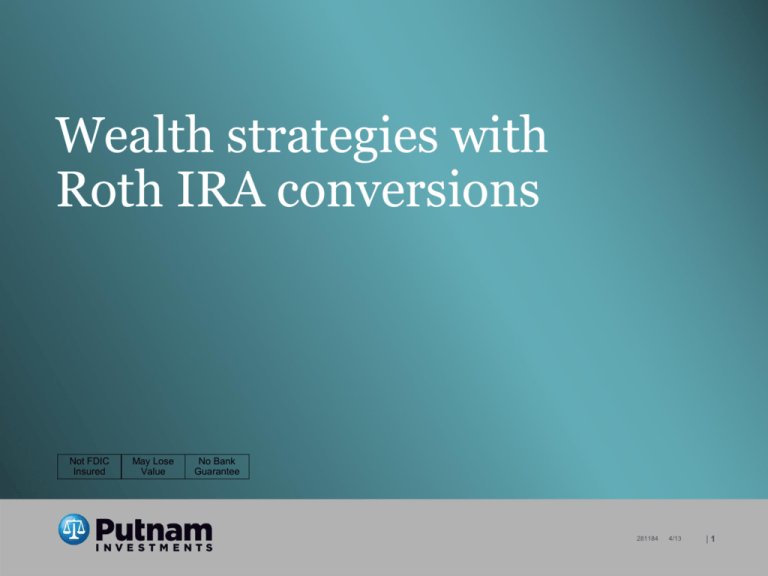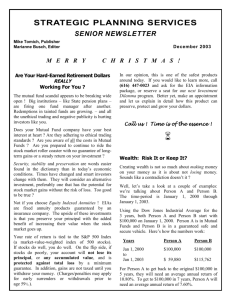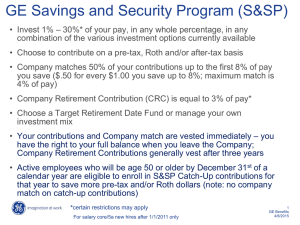Wealth strategies with Roth IRA conversions
advertisement

Wealth strategies with Roth IRA conversions Not FDIC Insured May Lose Value No Bank Guarantee 281184 4/13 |1 The retirement savings challenge We are living longer while “guaranteed” lifetime income sources, such as pensions, decline. And the responsibility for investment and lifetime income has shifted to the individual. 281184 4/13 |2 Sources of income in retirement Social Security Retirement plans and IRAs Personal savings 281184 4/13 |3 How are these sources taxed? Social Security Retirement plans and IRAs Personal savings Up to 85% included in taxable income Generally taxed as ordinary income Taxed based on underlying investments 281184 4/13 |4 Taxes on traditional retirement plans Income for expenses Federal income taxes A dollar inside a traditional (pretax) retirement savings account may only provide 60¢ of income in retirement 281184 4/13 |5 Taxes increase for some taxpayers beginning in 2013 Ordinary income Taxpayers with taxable income above $400K ($450K for couples) subject to a marginal tax rate of 39.6% Dividends and capital gains Taxpayers at same $400K/$450K income threshold subject to a 20% tax rate (0% rate still applies for lowest two brackets, 15% rate for others below the new threshold) Itemized deductions and personal exemptions Income phase-outs return for taxpayers with more than $250K in AGI ($300K for couples) 281184 4/13 |6 New health-care taxes take effect in 2013 • Increase in the individual portion of the Medicare payroll tax on wages from 1.45% to 2.35% • New Medicare investment income tax of 3.8% – Will affect interest, dividends, capital gains, rental income – Distributions from retirement accounts are excluded – Interest from municipal bonds not affected • Targeted at individuals with more than $200K income (couples with $250K income) 281184 4/13 |7 What is the likelihood of taxes increasing even more? Annual U.S. federal budget surplus/deficit, 2000–2012 ($B) ($) 500 0 -500 -1,000 -1,500 2000 2001 2002 2003 2004 2005 2006 2007 2008 2009 2010 2011 2012 Source: Congressional Budget Office, Monthly Budget Review, September 2012. 281184 4/13 |8 The aging of America will further strain the system Total U.S. population age 65+ 41 million Today 92 million 2060 Source: U.S. Census Bureau, Facts for Features, March 2013. 281184 4/13 |9 New rules opened the door to Roth accounts for everyone • Beginning in 2010, anyone can convert Traditional IRA or retirement plan assets to a Roth IRA • Roth 401(k) accounts and conversions are now available • Withdrawals from Roth accounts during retirement are not taxed, assuming certain requirements are met 281184 4/13 | 10 Wealth strategies using Roth IRA conversions Situation Roth conversion benefit Large % of investment assets in traditional retirement accounts “Hedging” strategy against future tax rate increases You won’t rely on retirement accounts for regular income No RMDs means more years of tax-free growth Retirement accounts have experienced market losses Converting while account values are low will result in less taxes You’re concerned about Social Security income being taxed Roth IRA income does not impact taxation of benefits You find yourself in a low income tax bracket A conversion can generate income to match against losses and deductions 281184 4/13 | 11 Using the Roth IRA to create a tax-free legacy • You are not required to take minimum distributions at age 70½ • Your beneficiary spouse does not have to take withdrawals • Non-spouse beneficiaries must take withdrawals, but the distributions are tax free • Paying income taxes at conversion can help lower the value of your estate if estate taxes are a concern 281184 4/13 | 12 Recharacterization: The Roth “do over” rule • This rule allows you to “undo” a Roth conversion by transferring assets back into a Traditional IRA before filing your tax return without any penalties or taxes • When might a recharacterization make sense? – Extra income from the Roth IRA conversion is too much – The account value has decreased from the time of the conversion 281184 4/13 | 13 Opportunities for certain small business owners • Certain business losses may be used to offset income from a Roth IRA conversion • These are known as “net operating losses” or NOLs • There is no limit on how much income can be offset by NOLs – Unlike net capital losses, which can offset only $3,000 in ordinary income each year • Consult with your tax professional for more information 281184 4/13 | 14 Factors you should consider before converting • Does a partial conversion strategy make sense? • Do you have assets available outside of retirement accounts to pay the taxes due at conversion? • Are you in a high income tax bracket now? • Do you expect to report significantly less income in retirement? • Are you applying for financial aid? • Will a Roth IRA conversion affect Medicare Part B insurance premiums? 281184 4/13 | 15 What’s next? • Identify all your retirement accounts • Talk to your advisor about a Roth strategy to provide tax-free income in retirement or for heirs – Does a Roth IRA conversion make sense? – If so, what portion of Traditional IRA assets should be targeted for conversion? • Consider converting assets incrementally to minimize the current tax bite 281184 4/13 | 16 A BALANCED APPROACH A WORLD OF INVESTING A COMMITMENT TO EXCELLENCE EO013 280390 281184 3/13 4/13 | 17 | 17 This information is not meant as tax or legal advice. Please consult your legal or tax advisor before making any decisions. Putnam Retail Management putnam.com 281184 4/13 | 18









